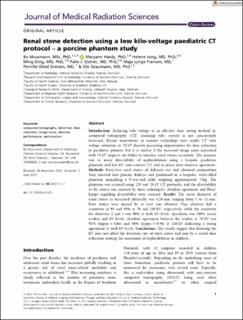| dc.contributor.author | Mussmann, Bo | |
| dc.contributor.author | Hardy, Maryann | |
| dc.contributor.author | Jung, Helene | |
| dc.contributor.author | Ding, Ming | |
| dc.contributor.author | Osther, Palle J.S. | |
| dc.contributor.author | Fransen, Maja Lynge | |
| dc.contributor.author | Greisen, Pernille Wied | |
| dc.contributor.author | Graumann, Ole | |
| dc.date.accessioned | 2021-09-27T14:20:49Z | |
| dc.date.available | 2021-09-27T14:20:49Z | |
| dc.date.created | 2021-06-23T12:58:33Z | |
| dc.date.issued | 2021-06-22 | |
| dc.identifier.issn | 2051-3895 | |
| dc.identifier.issn | 2051-3909 | |
| dc.identifier.uri | https://hdl.handle.net/11250/2783807 | |
| dc.description.abstract | Introduction: Reducing tube voltage is an effective dose saving method in computed tomography (CT) assuming tube current is not concurrently increased. Recent innovations in scanner technology now enable CT tube voltage reduction to 70 kV thereby increasing opportunities for dose reduction in paediatric patients, but it is unclear if the increased image noise associated with 70 kV impacts on ability to visualise renal stones accurately. The purpose was to assess detectability of nephrolithiasis using a bespoke paediatric phantom and low kV, non-contrast CT and to assess inter-observer agreement. Methods: Forty-two renal stones of different size and chemical composition were inserted into porcine kidneys and positioned in a bespoke, water-filled phantom mimicking a 9-year-old child weighing approximately 33kg. The phantom was scanned using 120 and 70 kV CT protocols, and the detectability of the stones was assessed by three radiologists. Absolute agreement and Fleiss’ kappa regarding detectability were assessed. Results: The mean diameter of renal stones as measured physically was 4.24 mm ranging from 1 to 11 mm. Four stones were missed by at least one observer. One observer had a sensitivity of 93 and 95% at 70 and 120 kV, respectively, while the sensitivity for observers 2 and 3 was 98% at both kV levels. Specificity was 100% across readers and kV levels. Absolute agreement between the readers at 70 kV was 92% (kappa = 0.86) and 98% (kappa = 0.96) at 120 kV indicating a strong agreement at both kV levels. Conclusions: The results suggest that lowering the kV does not affect the detection rate of renal stones and may be a useful dose reduction strategy for assessment of nephrolithiasis in children. | en_US |
| dc.description.sponsorship | The International Society of Radiographers and Radiological Technologists (ISRRT) supported the study financially via the Chesney Award 2018. | en_US |
| dc.language.iso | eng | en_US |
| dc.publisher | Wiley Open Access | en_US |
| dc.relation.ispartofseries | Journal of Medical Radiation Sciences (JMRS); | |
| dc.rights | Attribution-NonCommercial-NoDerivatives 4.0 Internasjonal | * |
| dc.rights.uri | http://creativecommons.org/licenses/by-nc-nd/4.0/deed.no | * |
| dc.subject | Computed tomography | en_US |
| dc.subject | Detection | en_US |
| dc.subject | Dose reduction | en_US |
| dc.subject | Image noises | en_US |
| dc.subject | Observer performances | en_US |
| dc.subject | Optimization | en_US |
| dc.title | Renal stone detection using a low kilo-voltage paediatric CT protocol – A porcine phantom study | en_US |
| dc.type | Peer reviewed | en_US |
| dc.type | Journal article | en_US |
| dc.description.version | publishedVersion | en_US |
| dc.rights.holder | © 2021 The Authors. | en_US |
| cristin.ispublished | true | |
| cristin.fulltext | preprint | |
| cristin.qualitycode | 1 | |
| dc.identifier.doi | https://doi.org/10.1002/jmrs.523 | |
| dc.identifier.cristin | 1917926 | |
| dc.source.journal | Journal of Medical Radiation Sciences (JMRS) | en_US |
| dc.source.pagenumber | 1-7 | en_US |

